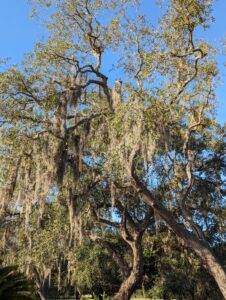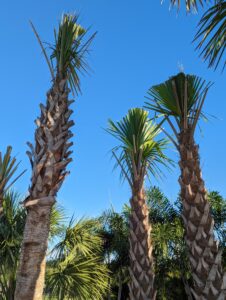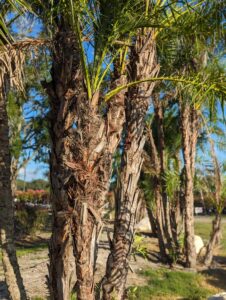By: Anna Stubbendick, FCHP
We all know that living in the Sunshine State comes with its perks – the endless beaches, the vibrant culture, and of course, the lush landscapes. But along with the beauty of Florida comes the reality of hurricane season, especially during the busy months of August and September. At Canterbury Farms Nursery & Garden Center, we want to make sure your trees, palms, and landscape plants stand tall against the storms. This past weekend we hosted a seminar on hurricane preparedness with a special guest speaker, Pete Lucadano, ISA Certified Arborist from Red Tree Landscape Systems in Pasco County. Pete offered some great tips and tricks, and we’ve included a few of them in this article in case you missed the seminar. So, let’s dive into some essential dos and don’ts to ensure your green giants stay strong and resilient.
Dos:
-

Contrary to popular belief, Spanish moss does not hurt trees. However, it may indicate that the tree was not quite healthy to begin with. Photo by Anna Stubbendick, Canterbury Farms
Trim with Tender Care: As hurricane season approaches, it’s a great time to give your trees and palms a gentle pruning. Remove dead or weak branches that could become projectiles in high winds. Focus on maintaining the tree’s natural shape to prevent excessive stress. It is important to keep in mind the airflow through the canopy of the tree during a storm. Trees that have overly dense foliage catch the wind more easily and are more likely to be uprooted.
- Deep Hydration: Proper hydration is key! Adequate water supply helps your plants build sturdy root systems that can withstand the onslaught of a storm. Ensure your trees and palms are well-watered a few days before a hurricane threat, but be cautious not to overwater, which can lead to root rot.
- Mulch Magic: A layer of mulch around the base of your plants can provide much-needed protection. Mulch helps retain moisture, prevents soil erosion, and offers an extra layer of insulation for the roots. Just remember to keep the mulch a few inches away from the trunk to prevent rot.
- Stake Smartly: Young trees might need some support during heavy winds. Stake them carefully to avoid causing damage to the roots. Make sure the ties aren’t too tight as you still want the tree to be able to have some natural sway so that it doesn’t snap off in high winds.
-

You may find some palms hurricane cut to facilitate transport, however recent research discourages that practice as a form of routine pruning. Photo by Anna Stubbendick, Canterbury Farms
Inspect Regularly: Regularly check your trees and palms for signs of disease or pest infestations. Weak plants are more susceptible to storm damage, so keeping them healthy throughout the year is crucial. (Side note: During the recent seminar, Pete answered a question about Spanish moss on trees. He noted that the Spanish moss itself does not harm the tree, but it may be an indicator that the tree is not as healthy as is could be. Typically the healthier trees tend to have denser foliage which does not lend itself to the growth of Spanish moss.) If you have questions regarding the health of your tree, it is always helpful to seek the advice of a certified arborist in your local area.
Don’ts:
- Hurricane Cutting Palms: During the 70s and 80s, it became a common practice to “hurricane cut” several species of palms, which involved pruning away almost all of the palm’s fronds, leaving just a few short fronds at the very top. However, recent research has found that this practice makes the palms more likely to be damaged in heavy storms. Scientists have found that Mother Nature knows best, and the natural canopies of the palms provide protection for the hearts, making them less likely to be snapped off in high winds. Pete recommended using the hands of a clock as a guide and giving your palms a 3 to 9 or 2 to 10 cut depending on the species, which means to only trim off the fronds hanging below the 3:00 or 9:00 hands.
- Over-Fertilizing: While it’s important to keep your plants healthy, avoid excessive fertilization before a storm. Rapid growth from heavy fertilization can make plants more susceptible to damage.
- Wrapping Trunks Tightly: Contrary to popular belief, tightly wrapping tree trunks with materials like burlap or rope can do more harm than good. It can trap moisture and encourage rot or even girdle the tree’s trunk as it grows.
- Ignoring Drainage: Proper drainage around the base of your plants is vital. Waterlogged soil weakens root systems, making it easier for trees and palms to be uprooted by strong winds.
-

It’s a good idea to remove boots from the trunks of palms if they are starting to rot, so they don’t become projectiles during a hurricane. Photo by Anna Stubbendick, Canterbury Farms
Ignoring Palm Boots: While palm trees naturally shed fronds, often the “boots,” which are the tough, woody base of the fronds, remain on the tree trunks. It is recommended to remove as many boots as possible, especially those that have begun to rot so that they don’t become projectiles. Removing palm boots can also help to alleviate problems with certain undesirable rodents.
As August and September roll around, keep a close eye on the weather reports and take proactive steps to prepare your trees, palms, and landscape plants for potential hurricanes. A little effort now can go a long way in safeguarding the beauty and health of your outdoor oasis. At Canterbury Farms Nursery & Garden Center, we’re here to help you weather the storms and keep your greenery thriving year-round. Stay safe, stay green, and happy gardening!
For more information contact your local county extension office, or visit these handy links:
Is my tree safe? Recognizing Conditions that Increase the Likelihood of Tree Failure
Disaster Preparation and Recovery – Trees and Landscapes


